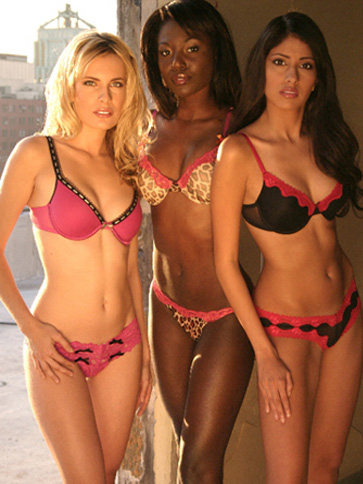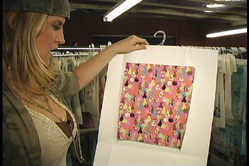 Jaymi Zentner has been the head designer of Biatta for nine years. Originally working in surf, skate and snow active wear, she freelanced as a bathing suit designer until she was offered a position at Biatta when she was only twenty-one. Jaymi took the position and commuted for two years from San Diego to Los Angeles, a two-hour drive. Because she was so young, she never really expected to stay with any one company for very long. But now, almost a decade later, she can’t imagine doing anything but lingerie.
Jaymi Zentner has been the head designer of Biatta for nine years. Originally working in surf, skate and snow active wear, she freelanced as a bathing suit designer until she was offered a position at Biatta when she was only twenty-one. Jaymi took the position and commuted for two years from San Diego to Los Angeles, a two-hour drive. Because she was so young, she never really expected to stay with any one company for very long. But now, almost a decade later, she can’t imagine doing anything but lingerie.
“I actually thought I was going to be a lawyer from the age four to seventeen. I was in a Poly-Sci class, and the professor saw me drawing dresses. In the middle of the lecture, he told me that my doodles would never make me any money. That day I dropped that class and decided to go to FIDM. I told my parents I wanted to be a fashion designer, but they had great plans for me to go to Stanford, Harvard, etc. It really didn’t go over that well. I knew I couldn’t be happy arguing for the rest of my life, but since I had to appease my parents, I attended both UCLA for communications and Korean language, and FIDM for fashion design concurrently. I never really thought I could make money with anything that had to do with really creative things. My father, who is a businessman, was also an amazing artist. He just did his art as a hobby. So I thought I would do the same thing, but quickly realized that wasn’t going to work for me.”
Jaymi designs pretty much everything that is Biatta. Kim Munoz, her associate designer, designs the Miss Fifi junior line, as well as assists her when she needs to get things done. She also has assistants that help with fabric buying and other processes.
“It’s great because I have this creative bond with four other people who really get what I want, and they really give me great input. We learn from each other.”
There are several segments within Biatta: one line is geared toward young contemporary; another line follows trends. There is the Biatta Collection, your day-to-day panties and bras. These garments have a lot to do with mesh and lace. There is Linear Essence, which is a basic sheer, striped fabric with a lace trim and high contrast colors. And lastly, there is the “seamless” program, a process done mostly in Europe in a special Santioni machine.
Most people do seamless in an athletic way, but Biatta does it in a pretty, feminine way. You can wear it under anything without panty lines, and at the same time, it is still really sexy and pretty. There are only a few fashionable seamless in the industry, and Biatta’s seamless has been well received. Jaymi describes the entire seamless process as somebody putting yarn into a dryer, and then opening the dryer, and suddenly there’s a garment.
seamless has been well received. Jaymi describes the entire seamless process as somebody putting yarn into a dryer, and then opening the dryer, and suddenly there’s a garment.
“When they showed me the seamless process, I thought to myself, this is the craziest thing I’ve ever seen! I was amazed, and I must have stood there and watched fifteen garments get made. It was incredible. It’s definitely like a little magic dryer.”
When Zentner thinks about the lingerie customer, she considers herself to be that customer—a fun person with a lot of personality who isn’t afraid of color.
“When you design for that person, it’s so much more fun because it’s not this basic ho-hum black-white, nude kind of thing. Although we have that business, but Biatta is known for their colors and prints.”
When putting the colors together for Biatta, Jaymi attends a lot of trend seminars. She pays attention to what colors she innately feels are becoming stronger colors. She even looks at interiors. She’ll shop at furniture stores just to see what they’re doing. After Zenter researches the trends, she puts together a palette. The front part of her palette is most likely her primary colors that she will be working with for that season. The secondary palette will be her accents, or more contemporary colors. Both palettes work well with both the younger, as well as older customer.
“I think lingerie traditionally has been more pastels, but I think that there are other women who feel sexier in brighter colors. So I went through a phase where I was doing a lot of bright fuchsias and oranges and teals. If you look through our line, I work with all colors to complement everybody’s skin tones.”
”After fifty-five seasons, I can still remember my first couple of seasons. I remember the infant stages of the company. It has changed so much since then. I remember back then we were designing these panties that literally went up to your belly button. It was insane. And now I look back and realize it has changed so much. The fashion now is to be quite low because pants are lower.”
Jaymi Zentner’s Highest Highs:
“There have been so many highs. I can’t even really pick just one. I think just seeing my stuff on stage makes me ecstatic. I also love it when I see someone wearing a Cami of mine as a shirt. Every once in a while a woman will wear my lingerie as a top to go out in. I was at a concert the other night and I saw someone wearing one of my tops. Another high is every time something comes out that I think looks really great, and there is a huge reaction to it. Those moments are precious.”
Jaymi’s Lowest Lows:
“When something that you loved in concept did not end up looking the way it should have, or didn’t sell—it makes you question yourself. It makes you feel like, gosh do I know what I’m doing? The self-doubt, those are the lowest times. Nobody wants to feel like they don’t know what they’re doing. But there will always be that group that doesn’t sell, and I don’t like it.”
Jaymi’s advice to young designers:
“Get an education, and then intern to get a feel of what you want to be doing. Put in the time because it’s really hard when rookie designers come in and they feel like they’re entitled. You have to work really hard in this business. It’s really competitive. You have to be willing to put in the time for free sometimes. The other thing that young designers need to know, and I don’t think schools are teaching them enough of, is they have to be computer proficient—that is where the competition comes from. Once they get the experience, and can actually draw everything on a computer efficiently, they have to pay some dues and be ready to be an assistant for a couple of years, and then good things can happen. There’s nothing better than a person who’s really excited about design. But people have to realize that part of design is not glamorous. It’s the follow-through and the production of it all. It’s making those great ideas come to fruition. If you can just get through that, then you have a lot of time to be creative. It’s awesome!”
Written by Kaylene Peoples